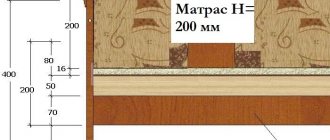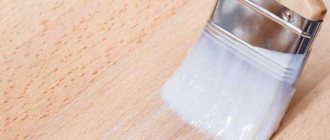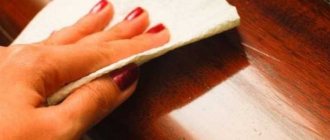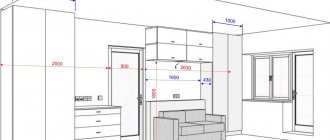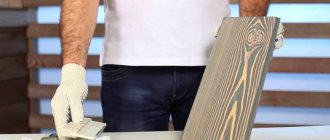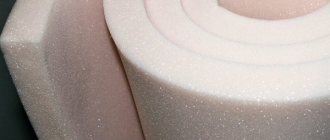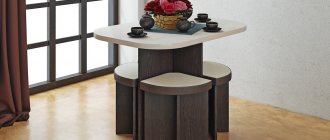Furniture
3
14 906
Share
The kitchen always serves as a special place in the apartment. In the kitchen, housewives prepare food, gather with the whole family, discuss everyday issues and relax over a cup of coffee. But there comes a time when a person has a desire to change something, refresh the renovation, or give an old kitchen set a new color.
- Replacing facades and doors as one of the options for updating a kitchen unit with your own hands
- Finishing with vinyl self-adhesive film: updating old furniture, marble countertops and more
- Paint finishing: secrets of decoupage on wood
- Finishing with paper and wallpaper
- Conclusion
But not everyone has the opportunity to purchase new kitchen furniture. Therefore, you can “update” your kitchen furniture using a new decorating technique called decoupage.
Decoupage is done using the following materials:
- Self-adhesive film.
- Paper.
- Glass.
- Leather.
Any available materials are used to decorate furniture and space. The DIY decoupage technique allows you to transform your kitchen, change the interior style, add variety to the design and refresh the kitchen. How to update your kitchen set with your own hands? Let's find out by reading the article.
about the service
Pasting furniture with film is relevant in several cases. Firstly, for example, if you want to update your furniture if it has become old, worn out or damaged. Secondly, if you want to change the color of the furniture, say from white to black, or, for example, you want to cover furniture that has a wood structure with a plain film, or vice versa, if your furniture is plain, but you want to cover it with a wood-like film, walnut or veneer. The main advantages of pasting are that, firstly, it does not take much time, secondly, there is a huge selection of colors and types of films, and thirdly, we can paste your furniture at your home.
What are MDF facades under PVC film?
The basis of the facades is MDF board. The abbreviation MDF “hides” the composition of the material. It can be quite loosely translated into Russian as “finely dispersed fraction.” In fact, the composition of MDF is wood dust, which is pressed under high pressure and baked. When exposed to temperature, binding components – lignins – are naturally released. MDF does not contain any other additives and is truly environmentally friendly.
But it is extremely unsightly in appearance.
The bare MDF board is grayish in color and resembles thick pressed cardboard. Due to its high density, the material can be milled, edge processed, and a 3D design applied.
And then prime the surface and paint. Or cover it with PVC film.
Facades covered with PVC film are also called film facades. The name is somewhat off-putting; it seems that we are talking about ordinary decorative “self-adhesive” film from hardware stores. In fact, this is not true. The PVC film is quite dense and is not just glued, but practically sealed with a thermo-vacuum press into the surface of the MDF.
PVC film can be smooth, matte, glossy, metallized, pearlescent, with sparkles (glitters), with relief.
Relief film is the most interesting. The relief can be fantasy or imitate some kind of texture. For example, the surface of linen, leather, stone. But most often it is a tree. The wood texture looks quite expensive.
MDF facades under PVC film can be “upgraded”. Add patina, like solid wood facades. Patina or finishing painting of the facade (most often “gold” or “silver”) is paid separately. As a result, with the correct selection of film, MDF PVC facades look almost identical to those made from solid wood. But they are also not cheap.
Photo printing can also be applied to MDF film facades. The technology allows you to scale any images and apply them with the effect of “flowing” from facade to facade.
But basically, of course, photo printing is more common on MDF kitchen facades and aprons made of various materials.
Advantages of covering furniture with film
- Moisture resistance, which makes it possible to glue the film both in the bathroom and in the kitchen
- Resistance to mechanical damage
- The ability not to change its properties at high temperatures (up to 80 degrees)
- Low cost of pasting
- A huge selection of different colors and types of films, which makes it possible to create an exclusive style in your apartment
- Pasting on any surface - the film can be applied to furniture made of wood, plywood, plastic, metal or glass
- Pasting takes minimal time
- The pasting process does not create any dirt or major inconvenience
- If necessary, the film can be quickly dismantled and a new one pasted
Pasting furniture facades at home
And now we propose to consider how to glue MFD film to a facade that has a flat surface.
To complete all the work that is planned, you will need the following tools and devices:
- White spirit.
- PVC film.
- Lint-free soft cloth.
- Wide and new spatula for plastering.
- Sharp scissors.
- Stationery knife (very sharp).
- Household hair dryer.
Please note that you should really only use a new spatula, since a used tool will still have irregularities that are almost invisible, and they will scratch the films during smoothing.
The upcoming work consists of the following stages:
Gluing PVC film to the furniture facade => preparing the surface for processing => cutting PVC film => gluing the material to the furniture => trimming excess film => final leveling of the finished surface.
Instructions for gluing the PVC coating yourself are attached below. Despite the fact that the described steps for gluing film on MDF are simple in themselves, the quality of the final result will largely depend on how accurately you follow it.
Instructions:
- First, you should thoroughly wipe the surface to be decorated using a rag soaked in white alcohol.
- Afterwards, in order to perfectly glue the MDF film to the furniture facade, measure the perimeter of the surface to be pasted and, according to the measurement data, cut the self-adhesive film with a margin of a couple of centimeters on all sides.
- Roll the self-adhesive material into a roll with the wrong side up.
- Place the edge of the film against the edge of the facade and separate the edges of the backing.
- Next, you should gradually unroll the roll and separate the backing layer.
- Use a spatula wrapped in fabric to smooth out the self-adhesive material so that there are no air bubbles underneath it.
- After the film is evenly glued over the entire surface, the excess film should be trimmed around the entire perimeter.
- Next, warm up the perimeter of the facade with a household hairdryer and additionally iron everything again with a spatula wrapped in fabric.
- Use a similar method if there are bubbles on the product.
If you follow all the instructions correctly, the result will be almost the same as on factory-made furniture facades.
Please note that a feature of adhesive-based PVC films is the small thickness of the material. As a result, even small specks of dust or irregularities on the surface being pasted will be visible to the naked eye. For this reason, you should wipe the facade with a damp cloth and check for dust under a bright flashlight or lamp before starting work.
Pasting tabletops with wood-look film
You are already familiar with how to cover furniture facades, and now let's look at how to finish a kitchen countertop. The main stages of the completed work will differ little from the previous method, so it’s better to just post a photo with explanations.
So, to begin with, the tabletop should be sanded using an angle grinder, and the grain size should be changed from medium to fine. The need for sanding is due to the fact that the tabletop will have a lot of chips and scratches on both the front side and the ends. Round depressions and scratches should be treated with a putty solution, and then the workpiece should be finally sanded and wiped with a lint-free cloth soaked in white alcohol.
After this, the tabletop should be laid in a horizontal position. We cut the pre-prepared film so that there is enough of it for the ends, and not just for the front surface. Apply the film, while gradually removing the backing and dispersing unevenness along the edges. When the main surface is pasted over, bend it at the ends. You should make cuts in the corners using a stationery knife and fit the bottom piece of film under the top one. Align the film along the end with a rag.
The remaining folds should be heated with a hairdryer and, once warm, smoothed out with a rag. After complete cooling, the film will stretch itself and the ends will be perfectly even.
Interestingly, the technology described above can be used not only for pasting furniture facades and table tops, but also for decorating furniture, large household appliances and other things.
Basic data about the film facade
Finally, I would like to shed more light on the topic of film facades, as well as what their advantages and disadvantages are. Film facades are a popular solution for making furniture mainly for bathrooms and kitchens. The scope of application of furniture made from such material is not accidental, since MDF boards coated with PVC film are resistant to high levels of humidity. That is, if there is no hood installed in the kitchen, and there is no effective ventilation system in the bathroom, then such furniture purchased by you will serve faithfully for many years.
Can you say the same about furniture that you covered yourself with self-adhesive vinyl? Unfortunately, no, since do-it-yourself tiled facades are not as reliable as factory-made analogues. Self-adhesive film, no matter how well it is glued, does not guarantee the tightness of the coating. Factory-made facades do not have open gluing areas, and for this reason, humid air will not have any effect on the MDF.
If we compare which is better - film, plastic or enamel for finishing MDF boards, it is worth noting that all coatings have their drawbacks, which should be taken into account when choosing pieces of furniture. But keep in mind that there is one drawback of film facades - the impossibility of restoring film that is damaged. However, the cost of the façade is reasonable and, if necessary, it will always be possible to update them entirely.
About protective films for pasting furniture
The main task of protective transparent film, as its name suggests, is to protect the coating (be it the floor or furniture) from scratches, chips and other mechanical influences. All protective films are divided into two large types: vinyl and polyurethane. Anti-gravel polyurethane film was developed and first used for the needs of the American army. It was applied to helicopter blades during Operation Desert Storm, because... otherwise the blades would wear out very quickly in the “sandy” air of the Middle East. Large manufacturers of vinyl films realized the advantages of polyurethane and began to use vinyl to protect coatings. After all, vinyl films were originally developed for advertising, signs and everything that is not subject to aggressive environmental influences. The fundamental difference is that vinyl film, in fact, protects only due to its thickness (usually only 100 microns), while polyurethane film protects due to its properties (but it is also twice as thick - 200 microns), the essence of which is that the film itself is a shock absorber between the surface and external factors that can damage the coating, what is most interesting is that the shock-absorbing effect of the polyurethane film can even be felt after pasting - simply by pressing hard on it with your finger - it will “spring”. In other words, we can conclude that protective vinyl film is more suitable for any vertical furniture surfaces that are not particularly susceptible to constant mechanical stress (for example, cabinet doors), while protective polyurethane film is ideal for protecting floor surfaces, such as laminate, parquet or Self-leveling floors.
Replacing facades and doors as one of the options for updating a kitchen unit with your own hands
You can update your kitchen set yourself by replacing the facades. Doors, cabinets and all accompanying accessories are called facades. By replacing new facades with old ones, you will give the kitchen a new appearance, which will make it impossible to distinguish the old kitchen set from the changed one.
In order to update an old cabinet with your own hands, you will first need to remove the doors from it and unscrew the kitchen handles from the hinges. Next, put new facades in place of the old ones. New facade parts are sold ready-made or ordered to order. It all depends on the wishes of the housewife and the size of the kitchen.
It is better to purchase processed parts. When purchasing untreated facades, you will need to spend a lot of time cleaning and painting them.
Replacement of facades is mainly carried out when they are broken.
If the old facades are in “working” condition, then to update them, the renovation technique is used using improvised means.
Do-it-yourself decoupage at home is created using available materials. Common materials for decoupage are paper, paint and vinyl film.
